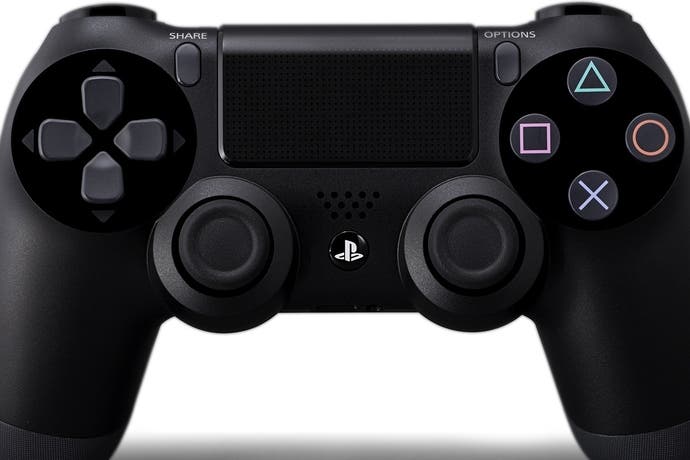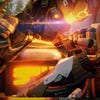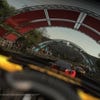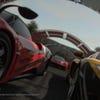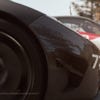Digital Foundry: Hands-on with PlayStation 4
After the 1080p60 dream, the 30fps reality?
It's Sony's time to shine. After a generation that kicked off with compromised multi-platform ports mixed in with some ground-breaking first-party efforts on PS3, there's a sense that it could retake a position of supremacy in the console arena by virtue of the new console's rock-solid core specs. And that's before we factor in the goodwill pouring out from enthusiast gamers because of its decision to stick with existing DRM standards. Unlike many of Microsoft's show-floor demos this E3, however, the use of genuine PS4 hardware among all developers also gives us a far more honest insight into the console's potential, despite making for a brace of nail-biting "will it? won't it?" moments during its conference.
Not everything goes to plan, but when it comes to the games it's clear there's a carefully plotted agenda for the PS4's tentative late 2013 launch. Given how Xbox One banner titles like Forza Motorsport 5 and Killer Instinct are running at a blistering native 1080p at 60 frames per second on day one, there's nothing truly equivalent competing on the Sony side in terms of fighters and racing sims. However, between Infamous: Second Son and Killzone: Shadow Fall, the bases are thoroughly covered for first and third person action titles, while Mark Cerny's mysterious platformer Knack brings some light-hearted respite to its online launch lineup.
The question is, for its faster unified GDDR5 memory and beefier GPU clocks, does Sony's first wave of titles actually bring the 1080p60 dream into focus? Or does this first wave of games more accurately represent the continuation of the console 30fps template? During our time at E3, we got a chance to test almost every PS4 title on display, allowing us to get a feel for where development stands for each of these core titles, plus some of the third-party efforts too.
Killzone: Shadow Fall
Perhaps the most recognised first-party PS4 launch title, Killzone: Shadow Fall's 5-10 minute demo at E3 could only be played in a guarded capacity - where much of the control is cautiously handled by Guerrilla Games' staff before handing the pad our way. It's a looker to be sure: gone is the utopian gloss of the Vektan capital shown in the game's reveal, and in its place we're given a lush jungle area plucked from within the first two hours of the campaign. It's a crowd-pleasing environment to showcase, and we're given plenty of options to explore it.
The goal of the demo is simple: navigate across a downhill stretch of hills and trees to reach an industrial Helghan stronghold at its basin. Linear corridors are kept to a minimum in uncharacteristic fashion for the series, and a broader dust-bowl level design is instead seen here, where objectives are tackled in any order - such as bringing down the communications tower, or finding your squad.. Methodical stealth is encouraged, as enemies are merciless health-chippers, arrive in a steady and unending flow, and prove difficult to pick apart in their set groups. This is something we learn the hard way.
Once we zip-line down to an outpost with all guns a-blazing, we get a taster of how AI behavior has been improved for the series' first PS4 entry. The guards in this forest area take up shotguns, and to intimidating effect, and tend to focus on working as a team to catch us unawares at short range - not firing once until they have us totally surrounded.
Lighting takes a leaf out of Battlefield 3's book here, and the Helghan soldiers' flashlights and distinctive red headlights heavily impair our vision with a strong flare effect. It's a genuine distraction, and in concert with the threat of a strong shotgun blast ending our session, we instead take the evasive option by backtracking up the hill. Here we find new lighting effects work extends to the addition of increasingly popular light-shafts, which stream between tree leaves as they rock and bend from the stem.
It's a beautifully realised area, packed with vividly sharp textures with the whole area being divided by a waterfall and stream. Level-of-detail culling is not noticeable on geometry at all either, which is an impressive feat given the broad scale of the vista. However, the obvious popping in of shadow elements is a distraction, and points to a lack of optimisation for this particular area given the absence of any shadow pop-in around the citadel area shown in Shadow Fall's first demo.
In terms of polish, the reluctance to give us a longer play-session does suggest other rough edges may be lurking in this build. But even so, the only glitch to be spotted is an occasional, split-second flicker to the light buffer as we run quickly across the environment. It's early days, of course, and we're also glad to see the native 1080p resolution in full evidence as it runs from the PS4 hardware. This bumped resolution suits the visuals wonderfully, save for water caustics and splashes which appear a little current-gen in nature. Guerrilla Games has proven it can handle massive, churning waves in its previous games, so we suspect improvements here are possible if there's enough time.
"When it comes to the tricky issue of control and response, Killzone: Shadow Fall currently delivers a largely 25-30FPS experience with v-sync, where a long overview of the forest tests the hardware most."
Aesthetically, we're being handed a very different beast to cult favourite Killzone 2, which was celebrated for its gloomy, monochrome visual style. Fans may not be best pleased with the continuation of a tonal shift that began with Killzone 3's more colourful palette, having itself offered a vivid Helghan Jungle multiplayer map via DLC. In its current form, Shadow Fall's campaign at least offers a breadth in gameplay style that we've seldom enjoyed before in Sony's flagship FPS series, but the apocalyptic grit and gloom is - at least so far - missed.
When it comes to the tricky issue of control and response, Killzone: Shadow Fall currently delivers a largely 25-30FPS experience with v-sync engaged, where a long overview of the forest tests the hardware most. A strong trace of input lag is felt when turning the analogue sticks - a quirk that hangs over from the Killzone 2 days. It's a delay in response that is impossible to ignore after playing snappier low-latency shooters, and at the default 50 per cent sensitivity for the X and Y axis proved tricky to adapt to. Migrating to the new and more shooter-friendly Dual Shock 4 controller isn't the cause here, as this is the only game we test with such problems. Rather, the issue is likely to be the result of latency being built up over the course of a long and complex rendering pipeline.
Sony's new gamepad brings with it a touch-pad - an addition that comes in handy for accessing new moves. A flying Owl auto-turret is accessible by pressing the L2 button, for which the touchpad is swiped in cardinal directions to activate its abilities - including a one-way shield barrier, and a mode which allows us to detect attach points for a grapple-hook. It's essentially used as another d-pad, where gestures access a new set of four hot-keys.
Other augments are accessed via the traditional d-pad method, though their placements are re-arranged from previous games. A slow-motion mode is engaged when scoped, allowing us to place each bullet at our own pace. This ability only activates in the seconds following the use of a health pack - accessed here by pressing down - while secondary fire is assigned to the left d-pad button. All in all, both the d-pad and the touch-pad gestures are well considered, and while it's a bit of a memory game at first, it's hard to imagine where the four extra abilities could have been mapped without the new input.
"Performance analysis of Bungie's Destiny E3 demo reveals a game that's firmly anchored in console 30fps territory."
DriveClub
Declared as pre-alpha code, MotorStorm developer Evolution Studios is quick to point out that the E3 build in demonstration is only 35 per cent complete. In such an early state, DriveClub doesn't hold up on technical grounds with the Gran Turismos and Forzas of the world, but the racing mechanics remain solid enough to engage us during a special E3 Club Challenge stage based in Kinlock, Scotland. As a launch-day racer, it's set to take advantage of the PS4's many new social features.
We're promised choice picks from all over the world in the final release, which makes us hopeful for something which rises above the drabness of the stage chosen here. With an Audi R8 V10 Plus locked into the "all torque no traction" club, we embark on one continuous road where the goal is to pick up best scores for average speed, time spent drifting, and momentum while cornering. Finishing line passed, our records in each category are planted next to a picture taken of our mugs right at the start, thanks to the ever-watchful new PlayStation Camera.
When questioned, Evolution Studios confirms that it's pushed for a full-fat 1080p presentation, falling in line with all Sony's other leading PS4 titles. Unfortunately, this higher resolution only amplifies the low quality, blurry, flat-looking textures used across this level, which would easily look at home on current-gen hardware. It's also a shame that, while the scenery draw distance is broad, there's an incredible amount of pop-in for trees and waving NPCs as we approach at high speeds.
"DriveClub is presented at 1080p, but the high resolution only serves to amplify the somewhat flat-looking textures which look somewhat current-gen right now."
To its credit, the cars look top-notch in terms of polygonal detail, and vehicle deformation uses a more realistic model that allows metal to crumple realistically over impact points. The interior cockpit view of our Audi R8, set by default, is also very well replicated and shows no sharp polygonal edges. It remains to be seen whether next-gen features like tessellation have made an impact here, but the results are very smooth indeed.
Despite the grey, overcast look of this Kinlock route, the lighting is realistic enough to bring much of it to life in exciting ways - especially while set to the interior view, where shadow lines pass over the dashboard. Each level is promised to feature a dynamic day-to-night cycle that has time running at accelerated speed to mark progress over the course of a track. It works, but can be oddly implemented at times, since we spot shadows shifting with unnatural speed across nearby walls during select turns.
With regards to performance, we're surprised to find DriveClub is running at 30fps with permanent v-sync - an unusual step for any modern-day racer putting heavy emphasis on shaving seconds from lap times. It is noted that 60fps is something the team strives for, but no promises can be made; in the interest of providing a smooth E3 experience it remains decidedly locked at 30fps for now.
"DriveClub could do with visual boost, but from a control perspective, the game makes the most exciting case for the PS4's new controller as an upgrade over the current Dual Shock 3."
Alas, even this number isn't held convincingly during our play-testing, and the game dips noticeably below this point - a feeling of 20fps being achieved during doughnut-turns, where lots of tyre friction smoke is produced. Bearing in mind the PS4's next-gen tech (not to mention its 32 ROPs), we're somewhat surprised to see alpha transparency effects still having such an obvious impact on performance.
Back to the positives, the game makes the most exciting case for the PS4's new controller as an upgrade over the Dual Shock 3. Feedback is extremely tight and responsive on the analogue sticks especially, despite all the performance hitches being thrown our way. This is due in no small part to a clear reduction in dead zone - making for a huge improvement when attempting gentle tweaks to the car's direction. The concave triggers, comfortably used for acceleration and braking, also feel much closer to those on the 360 pad. Racing fans will be relieved to finally have these in place.
Nothing much is made of the touchpad input, but an option for motion controls is inevitably included to take advantage of the gyro-meter. When twisting the pad to control the steering wheel, response is as wobbly as any other implementation we've tried, so it's a relief that the standard control set-up works so effectively. Sony's new controller is a marvel in ergonomic design, and by our reckoning the most improved of the two next-gen pads.
"We couldn't get hands-on with the PS4 version of Need for Speed: Rivals at E3, but we've got the next best thing - performance analysis of the demo as showcased at the EA press conference."
Knack
You'd be forgiven for thinking Mark Cerny's mascot action-platformer would have the initiative over other launch titles when it comes to taking advantage of the hardware, being directed by the PS4's lead architect. However, from a lengthy hands-on demo that takes us from suburban streets to a laboratory, and then through an icy, glacial cavern, this advantage has yet to fully materialise. The biggest selling point of Knack is the way debris from nearby objects is assimilated into the leading creature's body, be it lamp posts, post boxes, or blocks of ice. Empowered by what Cerny calls a "custom 5000 object physics simulation," Knack's body grows in this fashion until he becomes a titanic hulk of independently moving cogs and triangles - while getting hit means he loses a layer.
That's the next-gen hook, but little else is in place to enthrall. The Pixar aesthetic is let down by some muddy image quality, and heavily dithered shadows. We're promised 1080p native resolution here, but Knack doesn't look as crystal clear as we'd expect from such a pixel count - perhaps in part owing to the HDTV settings being used at the exhibition. It's a real disappointment on the grounds of image quality, and while the transparency effect on Knack and the big, beautiful ocean view during the first stage are visual treats, there isn't a whole lot to the rest of stages shown.
Certainly, the physics are impressive and technically taxing. All the bits and pieces that whip around Knack indeed feel like individual objects, taking advantage of the game's per-object motion blur. The only problem here is that, despite being a 30fps game in target, we see dramatic frame-rate drops when too many of these pieces go zooming across the screen to form a shell around Knack. To achieve this bullet-point trick, the performance has to take a noticeable hit in the current build.
Excluding this effect, the frame-rate isn't smooth for the current built in general, and it stutters even as Knack trots through empty streets unengaged. There's no evidence of tearing, but this choppy motion is surprising given its overtly simplistic visual style. Fortunately it evens out during the later interior stages based around the mansion and cave, but some optimisation is still clearly needed on the game before the PS4's launch.
Gameplay is based around hacking and slashing enemies in between spots of platforming. On facing the first stage's goblin enemies we're introduced to a double jump on the X button, after which we can pull off a Sonic-style homing attack from above. Dialing a combo between square and circle results in elemental area-of-effect attacks such as shockwaves and storms, which take up Sunstone Energy crystals (of which we have four to start - a number increased by discovering new items).
We see Knack's normal form in the second laboratory stage, where pressing the triangle button activates a switch between the titan mode and his tinier form. In this smaller state, the character passes through lasers unnoticed, and can also navigate ducts and passages for hidden objects. When the time comes for combat, all his previously collected bits and pieces suddenly fly across the screen with a single press of the triangle button, and he reassembles. Transitions are on-the-fly as the little mascot runs, rather than pausing his motion to complete assembly, which makes switching feel satisfying and smooth.
"Directed by PS4's lead architect, you may expect Knack to present a clear advantage over other PS4 games. Unfortunately, this isn't the case based on the demo build we played at this year's E3."
A charming visual style can't fight this battle alone, however, and we'll need to see more depth to the gameplay before passing full judgement on Knack. Our hope is that the game's final retail release is set to focus on exploration side of the adventure, and possibly bring some more complex puzzle elements into the fray based around the form-switching mechanic. As it stands, based on the sampler we've played, it doesn't feel that there's enough meat to the combat, and the level design is too linear to reward curious minds.
Infamous Second Son
The fourth major first-party release for PS4, Second Son is set seven years after Infamous 2, starring a new fiery protagonist: Delsin Rowe. Unlike his forebear Cole McGrath, who predominately used lightning powers to glide and attack, this new hero bases his move-set on the properties of smoke and fire. It looks like riotous fun, and destruction appears to be a much bigger feature when interacting with the sandbox world; bridges come crumbling down between buildings, which affects the field of play significantly more than in previous games.
At a confirmed 1080p resolution as well, Sucker Punch's latest is the most polished and CGI-like title on display. It looks gorgeous in play, with its per-object motion blur being up to God of War: Ascension's lofty bar of quality, and the character's pyromaniac moves bringing out the developer's sterling effects work. The visual standard is unlike anything we've seen achieved on PS3: Delsin swaps to a smoke form in the blink of an eye while lunging at opponents with fiery fists, lit particles fly, and the billows light up brightly with each flaming swipes. Heat haze effects also make an appearance, making every punch and glide a sight to behold.
"It takes a seriously impressive game to make jaws drop at Digital Foundry - Sucker Punch's latest was the biggest surprise for us."
The frame-rate is very consistent too, and there's no obvious pop-in on the horizon when bounding across rooftops. 30FPS may be the target, but it's easy to believe the game's running at double that given how travel and effects-heavy explosions scarcely drop frames - a testament to just how much visual fluidity is improved by operating at a locked frame-rate. Traversal is swiftly animated too, with ducts and vents used to transport a smokey form of the character to the top of buildings. For the traditional approach, parkour climbing animations appear largely unchanged from the last game, and the game still falls short of the more dynamic approach seen in the Uncharted series. Elsewhere, there's no evidence of touch-pad controls being utilised, but it's safe to say there are plenty of in-game options for getting around the city. Leaving E3 behind, Second Son counts as one of the biggest surprises of the PS4's launch lineup, and will certainly be one to watch.
Assassin's Creed 4: Black Flag
We get a proper next-gen upgrade to the Assassin's Creed series on PS4, with jungle environments producing a far more impressive looking game than even a DX11-enabled PC version of Assassin's Creed 3. The decision to go with a Caribbean theme means nailing a convincing vegetation system was a must for Black Flag, and Ubisoft Montreal has delivered. The plants look incredible in motion, with a dewy reflective layer that comes alive under the moon's lighting, and a convincing level of opacity that lets light shine through to their undersides. Unlike even Far Cry 3, these ferns bend, flop and sway as protagonist Edward Kenway sneaks through them - likely to be a factor when stealthily pursuing NPCs or the hunting wildlife contained in the thickets.
The unstable performance of the game's Sony conference appearance isn't in evidence during our private look at the game, and there's no frame-rate dips at all during its 10 minute stretch - while reports came from the showfloor of a 60fps multiplayer experience, this was clearly a silky-smooth 30fps presentation. The demo takes us from a night-time camp on the coast as Edward trails after Black Beard, to seamlessly walking onto - and then commandeering - the Jackdaw ship where all hell breaks loose on the seas. Alongside the stealth elements, this sense of seamlessness in traveling from land to sea is claimed to be a big focus, and we're promised we can even make leaps to other boats by locking ships side-by-side.
"One of the stand-out PlayStation 4 games at E3, Assassin's Creed 4 is a proper next-gen update, seemingly locked at 30fps but fluid in motion."
Environments are more variable too. Simulacrums of Caribbean towns like Havana, Kingston and Nassau have already been declared - plus jungles, underwater segments, and smuggler's coves. The only disappointment is in the blandness of some textures around the initial camp area which, compounded by some rigid geometric designs, suggests some elements are being curtailed on next-gen by the limits of the pending PS3 and 360 versions. However, smoke effects mist, haze, light-shafts (a new addition), and lighting look far more refined than anything we've seen from the series on console. There's no absolute lock on the resolution as yet, but all signs point to the full 1080p based on the clarity of the image shown here.
As far as controls go, our demonstrator doesn't use any PS4-specific features like the touchpad, so it's very much business as usual for interacting with the game world. Assassin's Creed 4 is being primed for day one release on PS4, whenever Sony is able to cement its release date - though Ubisoft staff do warn there's a chance it could slip. It's in development for just about every major home console platform under the sun, including PS3, PS4, PC, Wii U, Xbox 360 and Xbox One. As far as Face-Off feature subjects go, this will be one to look out for...
Thief
In production at Eidos Montreal for the last five years, this series reboot is shown running in a pre-alpha state straight from PS4 hardware at a targeted 30fps. The demo places us a few hours into the full game, where leading assassin Garrett tip-toes through a rainy night-time court-yard, and up towards a Gothic manor. Staying hidden in the shadows and mists as best you can is clearly key, and the use of quick strafe dashes (activated by light tilts to the PS4's pad) to avoid dogs and guards is essential while scouting for secret passageways.
Thief plays from the first person perspective, but toys with its camera-work. Garrett's hands often appear in front for animations involving searching for keys around portrait edges, or turning corners - which he delicately wraps his fingers around on approach. After collecting a Heart of a Lion item, a rope-arrow is fired up a building spire, which forms a quick escape plan to the rooftops of the mansion. The perspective changes here again - very smoothly - to better show how Garrett's clambers around the building's ledges and statues.
When it comes to performance, the game is v-synced, but very jittery in the frame-rate stakes for transitions into new areas, and throughout an entire sequence where a bridge burns to cinders. It also appears to run at native 1080p, though there's little being achieved here visually which we haven't already seen before, likely showing its prior development history on weaker platforms. That is, with the exception of its impeccable lighting - a striking feature as lamp-light streams through the city's fogged archways, and one which feeds into a gameplay design predicated on hiding in shadows.
A curious trend among other next-gen game we've seen - such as Killer Instinct - is the decision to ramp up the particle count to dazzling degrees for explosions. That's true here, where lighting on particles is truly striking as flaming debris crumbles down from a bridge during one later segment. It's only a shame that surrounding texture-work and alpha effects appear so mismatched with these more "next-gen" elements in this current build, and we hope to see everything ramped up to an even level for the final release.
"In production at Eidos Montreal for the last five years, this series reboot is shown running in a pre-alpha state straight from PS4 hardware at a targeted 30fps."
Hands-on with PlayStation 4: the Digital Foundry verdict
We leave Sony's E3 booth undoubtedly impressed, with two key takeaways in light of the Xbox One's rivalling offerings. Firstly, though almost all launch titles on show appear to be running directly from PS4 hardware, it's a touch disappointing to discover the likes of Thief and Assassin's Creed IV: Black Flag are only currently being demonstrated by proxy of an on-hand developer. This was a very closely guarded event indeed, suggesting a lack of confidence in the progress of development for some of these titles. Even so, Knack, DriveClub and Warframe do give us absolute, no-holds barred freedom to toy with the most current builds as long as we please.
The second point is that the majority of titles here, from the long-awaited Thief reboot to the CG-like Infamous: Second Son, are overwhelmingly poised for 1080p native output whilst running at 30fps. The sacrifice of 60fps does have its benefits: as far as visual quality goes, Sucker Punch's flame-throwing action title in particular leaves us with our jaws most agape. It looks gorgeous in motion, plays without skipping a beat, and the effects work is quite unlike anything we've seen on current-gen platforms. While this isn't a hands-on session, the new front-man also looks immediately satisfying to control.
"No smoke or mirrors from Sony - everything we saw was running on PS4 hardware. But it's still early days and many of the games clearly require a lot of optimisation."
Our most hotly anticipated game is Killzone: Shadow Fall, and we aren't disappointed by the breadth of the gameplay slice we're handed, even if it is brief. Based on the sub-30fps performance and LOD streaming issues, certainly Guerrilla Games has some work to do on this forest section before its confidence rises to a point where any player can explore it at their leisure. The foundation of play is largely intact for long-time series fans though, and the touchpad controls open up some enticing new tactical options for multiplayer. We're confident that this section's rough edges - absent from the earlier Citadel demonstration - will be smoothed out by the time of release.
When it comes to the state of software development on PS4, the situation as it stands is surprising. On the one hand, freely playable first-party titles such as Knack and DriveClub suffer from noticeable frame-rate stutters down from 30fps, while on the other, "hands off" demos for the new Infamous and Assassin's Creed games appear to run without a perceptible hitch. This is in stark contrast to the playable software confirmed to be running direct from Xbox One hardware, such as Forza Motorsport 5 and Killer Instinct, which benefit to no end for targeting the 1080p60 gold standard, and largely succeed in doing so.
Such a disparity in performance is far from the outcome we had expected going in to E3, but Sony's agenda with this initial wave of games is clearly hinging on visual fireworks rather than maximising frame-rates to the full 60Hz refresh. In the case of Guerrilla Games' and Sucker Punch's sterling work, the pay-off speaks volumes through the screens, and we're left itching to jump into both come their European releases. Christmas can't come soon enough.
